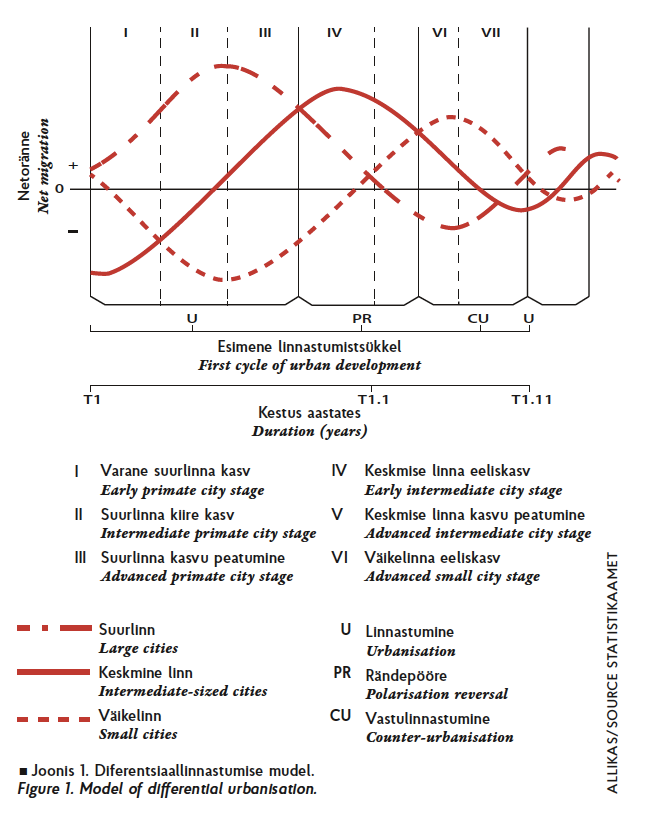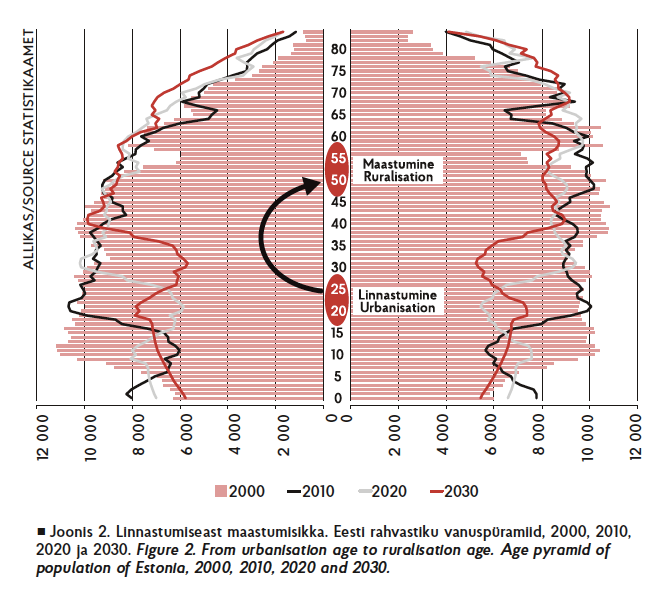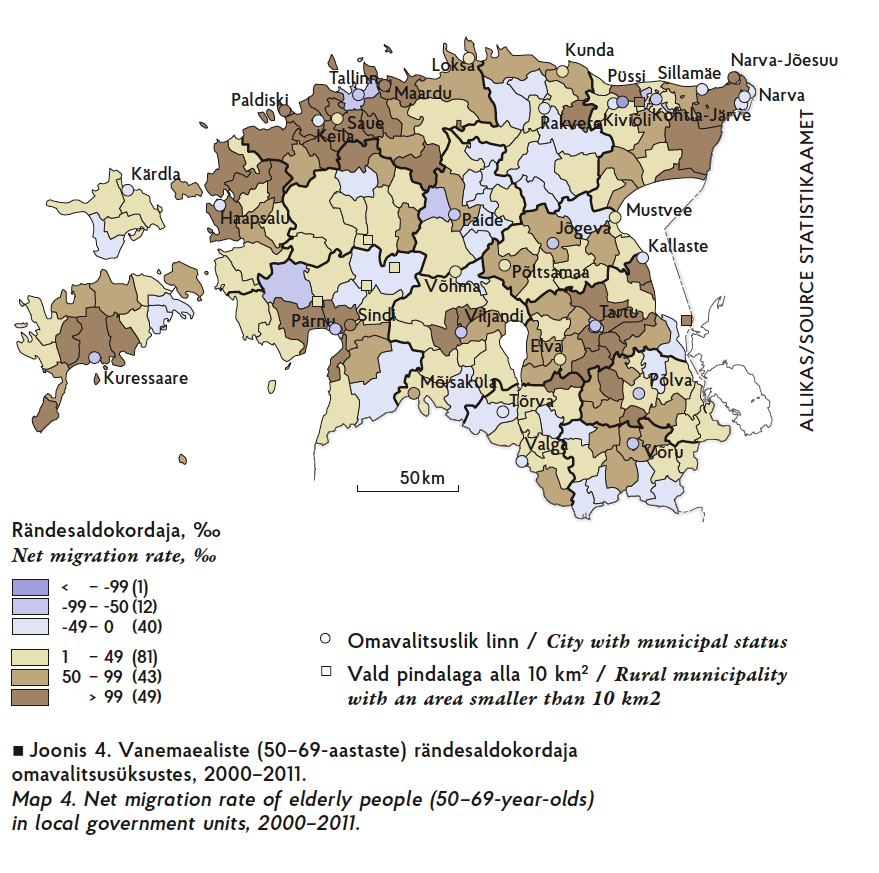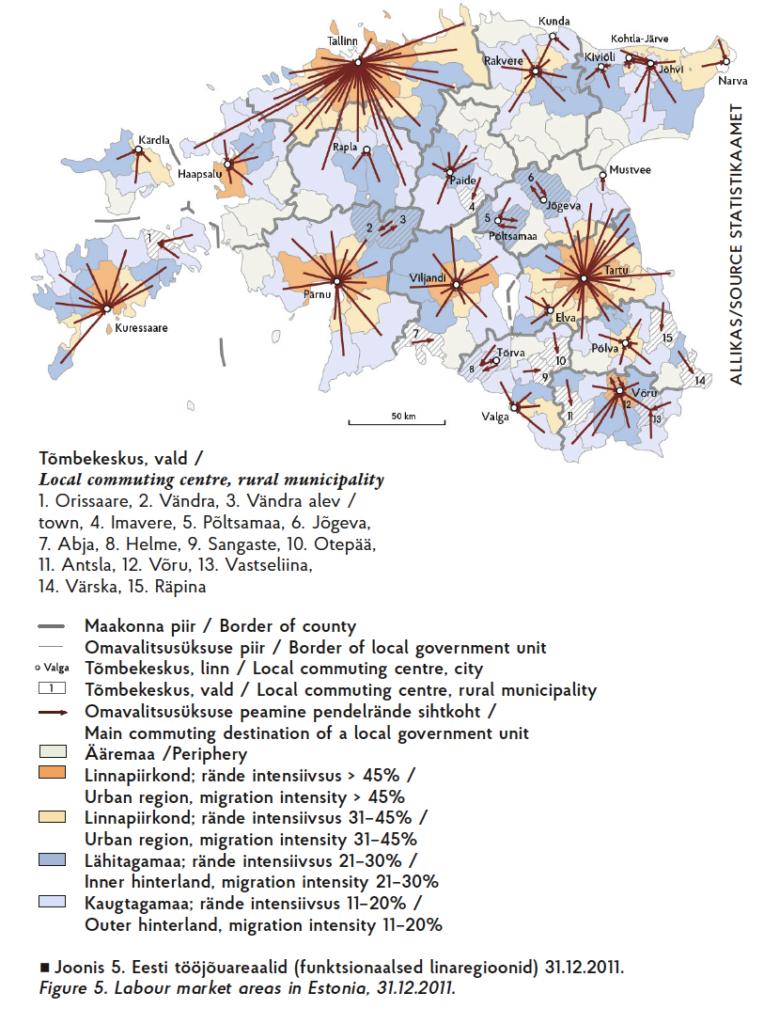To what extent does the administrative reform correspond to long-term settlement changes and the National Spatial Plan Estonia 2030+?
The aim of this article is to assess the impact of the administrative-territorial reform (ATR) and the National Spatial Plan Estonia 2030+ on the settlement system with a special focus on the long-term sustainability of small towns, i.e. the viability of the Estonian population and Estonian culture. Local governments play a crucial role in this. In addition to providing everyday services, they plan housing and industrial areas, make local decisions and lobby upper-level administrations in order to build roads, harbours, airports, water supply and sewerage systems and also social infrastructure: schools, kindergartens, sports facilities and pools that should still be able to used in 2050 and beyond. The ATR, the main goal of which is to optimise administrative expenses and improve capability, will thus inevitably influence the spatial positioning of society’s backbone and its dependant settlements. Local authorities also build the identity of places and enhance their global visibility. Cities whose residents and companies are proud of their place tend to be more successful – this invites people to live there and encourages outside investments.
On a global scale, Estonian cities are small and located on the periphery of Europe. Only Tallinn can measure up to the world average and is considered among the smaller MEGAs1 on maps of Europe. The number of inhabitants in Tallinn’s functional urban area (FUR)2 has reached close to 600,000. Second largest city Tartu and its hinterland is four times smaller. Other urban regions around county centres are well behind with 10,000-80,000 people. Settlements that are globally regarded as villages and industrial settlements are categorised as (small) towns by the Estonian National Spatial Plan. All areas outside of the urban regions of Tallinn and Tartu are losing their residents.3 Will this continue in the future?What effect could the 2017 administrative reform have on this?
Is metropolisation the only way forward?
In the past few decades, people all over the world have concentrated into metropolitan areas4, especially rapidly in Asia and developing countries. Some officials, politicians, economists and even the World Bank5 believe that relocation driven by market powers and concentration around metropolises should be encouraged. Even in Estonia it has been said that Tallinn is too small.
According to the OECD6, the competitive advantage does not lie in the size of a city, but in the general urban economic environment and the structures necessary for participating in the global economy. Germany, Switzerland and Slovenia are wealthy despite not having any megacities. Metropolisation is neither the only nor the most sustainable long-term solution for distributing the world’s population. Even though it encourages short-term economic growth, it also has negative consequences such as increased energy consumption (due to transport and the need to cool overheating buildings), pollution, infrastructure investments and traffic congestion costs and social problems such as segregation, poverty, crime and possible unrest. The contrasting poverty on the periphery makes people migrate to metropolitan slums and cross borders to reach Europe.
Waves of settlement development
Metropolises start to shrink as they reach a certain development stage. Growth continues until resources (e.g. water) are depleted and/or the factors influencing deconcentration become more pronounced. The concept of differential urbanisation7 (Figure 1) describes (I) urbanisation waves, i.e. migration towards the largest centres, (II) deconcentration of (large) cities and finally, upon the concurrence of certain conditions, (III) counterurbanisation and migration to small towns.
Modern people follow certain stages in their life cycle. Young people move to cities to study and make a career while families look for places that offer them both a well-paid job and a safe living environment for their children. Choices made in retirement depend largely on the price and quality of the living environment. In the last 15 years there has been mass urbanisation and migration of the Estonian baby boomers of the 1980s, especially during the recession from 2009-2011. In the 2030s, this generation will pass the age of 45, after which people will begin to gradually withdraw from active employment and move to places with more value on the environment. This has been the case with late-middle-aged people in Estonia and Europe (maps 5 and 6). Estonian small towns may grow with the help of Estonian expats, many of whom return home or inherit real estate from their parents or relatives. The number of second-home owners from core Europe has grown in the Mediterranean countries, but also in southern Sweden and elsewhere in the Nordic countries8. Rail Baltic and the improvement of other connections may boost these processes further.
Technology-based development cycles and green dispersion growth
Technology is another factor that shapes settlement structure. Every 40-50 years, the world economy plunges into decline in order to rise again with the help of new technology. Such technology-based development cycles are called Kondratieff cycles9: the productivity of companies decreases during crises and some companies of the old economy disappear, giving new ones an opportunity to grow. The economy is restructuring but some old industrial areas fall into decline: just like Manchester after the second and third wave or Detroit after the fourth.
The financial crisis of 2008 marked the end of the fifth Kondratieff cycle and indicated that Earth – which had globalised in the second half of the 20th century through advances in microelectronics and aviation – had fallen ill. Oil, which has kept the economy running for the last century, can no longer be used as a fuel, because climate change threatens to destroy the living environment of billions of people.
The field of ecoenergetics is likely to grow, but this requires more space. Wind turbines can be installed in places where there is wind and the locals tolerate it. Solar panels should be installed near consumers, but there is limited room for them in large cities. In order to keep transport costs low, the best place for a biomass cogeneration plant is close to energy resources, industrial and residential areas and consumers.
The green economy concept also involves saving energy and better planning. The geography of settlements optimised through the use of energy and time differs greatly from the current situation. Life in a metropolitan environment, which depends on massive amounts of energy, food and water, is likely to become even more expensive with the introduction of new environmental taxes. People in highly motorised and dispersed megalopolises have a considerably larger ecological footprint than small-town residents.10
And not only that. Putnam11 writes about how Americans are losing their friends and an ever greater part of their family life by “bowling alone”. Commuting between their suburban home and metropolitan office takes a lot of time that could be spent more productively. More extreme and drastic results of a lack of spatial policies and the stigmatisation of small towns as depressing can be observed in overurbanised developing countries.
The Resurgence of Geopolitics
Governments in countries on Europe’s (eastern) border are likely to be forced to subject development trends in hinterlands to critical review due to changes in the geopolitical situation. Major countries like Russia, China, Iran and Japan have begun to redistribute spheres of influence. From this, Raivo Vare12 concludes that geopolitics has made a comeback. The methods used, however, date from the pre-World War II period.13
“How do we survive in a world where electricity has disappeared from cities, the oil tankers have run dry and supermarket doors remain closed? We still haven’t fully realised how much the situation has changed.”14 Still, some people are worried, as the increased presence of NATO units shows. Many state officials interviewed recently by the author considered security the most important reason for ensuring more consistent settlement development. Estonia requires a plan for dealing with extreme circumstances, with a special focus on dispersed settlement and small towns.
Future settlements and National Spatial Plan Estonia 2030+
Policies influencing the long-term development of Estonian settlements should change, because the growth and spread of the city region of Tallinn in the last two decades is not sustainable for several reasons. In addition to the above three sets of factors influencing settlement, future economic, regional and urban policies should also follow the National Spatial Plan Estonia 2030+15, according to which the value of achieving spatial balance lies, above all, in better use of resources and the need to keep commuting within reasonable limits: “Functional areas cannot be extended endlessly. The maximum preferred commuting time remains under 45 minutes in 69% of cases.”
E2030+ aims to balance out the national settlement system through a network of county centres as functional urban areas (see Figure X1): “The viability of small towns and rural settlements must be ensured via better connections with county centres and other cities within daily activity spaces.” Without economically viable county towns, the surrounding area (together with small towns) also tends to lose its attraction.
The government’s decision to dissolve county governments has left functional urban regions (Saaremaa excluded) without administrative leadership and is unequivocally inconsistent with the national plan established by the previous government. Local governments are expected to fill this void.
Administrative reform and development of small towns
As a result of the administrative amalgamation, several small towns (such as Lihula, Otepää and Tõrva) gained residents and taxpayers, which is thought to benefit their development. This is supplemented, to a degree, by funding from the central government, which is why the post-reform budget may seem like a significant step forward, even though it is being used to take care of people living in a much bigger area. Unfortunately, there are only a few daily commuting areas with 5000 residents (see Figure X2).
The development of cities with far larger hinterlands such as county centres Rakvere, Viljandi and Võru, which remain alone, but also Haapsalu, Paide and Pärnu, which merged with only a few of their neighbours, remains a serious concern. These cities are seen as a source of services, but their hinterlands willingness to contribute is low. There is a threat that some service functions of county centres will be duplicated in merged rural municipalities in the hinterlands. The small rajoons (administrative divisions during Soviet Union, similar to contemporary counties) of the 1950s built impressive office buildings. In the 1980s, collective farms and state companies built sport halls and swimming pools in small towns, not in the aforementioned county centres where they naturally belong.
And now to the most important part. Someone has to bring local entrepreneurs and other parties together, (co-)finance enterprise development centres, plan and build infrastructure and transport routes and develop education on a larger scale than the existing local governments. If a region cannot or will not cope with the establishment of new companies and their entry into the market, there is no hope of attracting young educated people. There is no use renewing social infrastructure and services in declining regions, and the quality of life will drop even more compared to core areas.
Therefore, small towns depend on the capability of county centres that are higher up in the hierarchy and more capable of creating new jobs and offering services. A unit with fewer than 10,000 employees is generally not capable of business promotion. This is why the lower limit of the administrative reform was set at 20,000 residents in Denmark and Finland. Will the new leaders of small towns see the need for developing transnational entrepreneurship capacity, a support system for innovation and the advantages of joint service production, so that these can be co-financed? Based on Estonia’s local administration history and the experiences of Europe16, they generally tend to be satisfied with the position achieved and the benefits it brings.
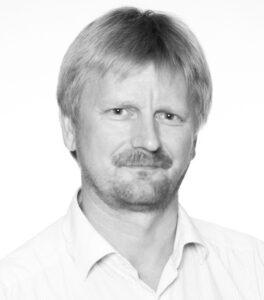
GARRI RAAGMAA (PhD in Human Geography) has studied the impact of new businesses, regional identity, innovation, leadership, administrative structures and peripherisation on regional development and published more than 70 research articles in international publications.
PUBLISHED in Maja’s 2018 winter edition (No 92).
1 Metropolitan European Growth Areas.
2 A city together with its surrounding hinterland, which makes up the daily commuting zone, with more than 15% of the residents of its satellites travelling to the city core according to the OECD. See the OECD’s definition at https://www.oecd.org/cfe/regional-policy/Definition-of-Functional-Urban-Areas-for-the-OECD-metropolitan-database.pdf.
3 http://pub.stat.ee/px-web.2001/Database/Rahvastik/01Rahvastikunaitajad_ja_koosseis/04Rahvaarv_ja_rahvastiku_koosseis/04Rahvaarv_ja_rahvastiku_koosseis.asp
4 http://www.espon-usespon.eu/dane/web_usespon_library_files/1200/de_metroareaeu_2011.pdf
5 WB (2009). World Development Report 2009: Reshaping Economic Geography. World Bank.
6 OECD (2006) Territorial Reviews Competitive Cities in the Global Economy.
7 Geyer, H. S., Kontuly, T. (1993). A Theoretical Foundation for the Concept of Differential Urbanization. International Regional Science Review 15, 157–177.
8 Müller, D. K. (1999). German second home owners in the Swedish countryside: on the internationalization of the leisure space. Umeå.
Nordregio. (2007). Second homes in the Nordic countries. – Journal of Nordregio, Vol. 7-2007.
9 Schumpeter, J. A. (2006) [1939]. Business cycles: a theoretical, historical, and statistical analysis of the capitalist process. Mansfield Centre, Connecticut: Martino.
Perez, C. (2002). Technological Revolutions and Financial Capital: The Dynamics of Bubbles and Golden Ages. UK: Edward Elgar.
10 Poom, A (2017). Spatial aspects of the environmental load of consumption and mobility. University of Tartu Press.
11 Putnam, R. D. (2000). Bowling Alone: The Collapse and Revival of American Community. New York: Simon & Schuster.
12 https://arvamus.postimees.ee/1363542/raivo-vare-miks-venemaa-ukrainat-kiusab
13 Mead, W. R. (2014). The Return of Geopolitics. The Revenge of the Revisionist Powers. Foreign
Affairs, May/June. [www] https://www.foreignaffairs.com/articles/china/2014-04-17/returngeopolitics
14 http://ekspress.delfi.ee/intervjuu/kaido-kama-ellujaamisopetus?id=72333675
15 https://eesti2030.files.wordpress.com/2015/12/a4_5mmbleed_eesti-2030_sisu_111212.pdf
16 Barca, F. (2009) An agenda for a reformed cohesion policy. A place-based approach to meeting European Union challenges and expectations. http://ec.europa.eu/regional_policy/archive/policy/future/pdf/report_barca_v0306.pdf


